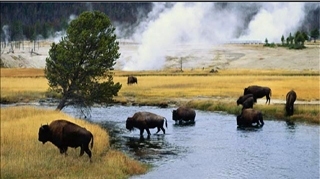Question from February program
When was the 1733 dance hall blown down?
(Phone call on April 12 from Bill Nichol)
Bill and his wife were returning to Kearney
from Denver in late April 1964.
They
ran into a storm at Gothenburg and did not drive out of it until Odessa.
It was after dark,
of course, but as they drove passed the 1733 dance hall site, he could see
in the headlights that it was all flat in the ground.
He said it was a big
building, about 100 feet by 150-200 feet with booths around the edge.
Bill also remembers
the swimming pool south of the dance hall
[the dance hall and swimming pool were probably
all that was left if the amusement park features of past years]
As a high school student,
his father and his friends used to swim there in the 1930's
There
was a diving tower about 25 feet high.
The game was to dive into a tractor tire inner
tube. The trick was to avoid the valve stem.
Another Question – Why is there no Avenue J?
1876
Map of Kearney
5 years after D N Smith designated the site of Kearney
1. East/west
streets
According to the earliest map of Kearney we have, dated 1876, it was 22
blocks north/south, and 14 blocks east/west
The first 12 east/west streets were numbered as they are today, but since
Kearney was smaller then, the numbering began at what is now 12th Street.
That
put 9th Street at the railroad where 20th Street is today.
Rather than name the street after 12, 13th Street, it was called Smith
Avenue. That is today’s 24th Street.
Today’s 25th Street was Grand Avenue, then came Minneapolis Avenue, Greeley
Avenue, Gibson Avenue, Sidel Avenue, Pawnee Avenue (present day 31st
Street), Omaha Avenue and Grove Avenue.
2. North/south
streets
The main north/south streets began on the east side of town at what today is
Avenue E.
The
first four streets were named for our railroads – Union Avenue (E), Pacific
Avenue (D) Burlington Avenue (C) and Missouri Avenue (B).
The next four streets had the names of states – Nebraska (A), Wyoming
(Central), Colorado (First), and Dacota Avenue (Second)
3. Northwest
Kearney – the Perkins & Harford Addition
To add
to the confusion, there were no streets and no homes west of Dakota in the
south part of town.
But
from the corner of Smith and Dakota (today’s 24th & Second) there were homes
and named streets in the Perkins & Harford Addition, a six by 9 block area.
While
the streets running west remained the same as the Original Town: Grand,
Minneapolis, etc., those going north/south were numbered First through Sixth
Streets, the same names as the east/west streets on the south edge of town.
1889 Map of
Kearney
Boom period Kearney has grown
Present day Avenue N on the east to 9th Avenue on the west; 11th Street on
the south to 39th Street on the north
City council had decided as these new streets were added that a new system
of naming needed to be adopted.
East/west streets = Streets; north/south streets = Avenues
Numbers would continue to be used for the east/west streets, but the
numbering would begin at the north channel of the Platte (today called
Turkey Creek)
The
former Wyoming Avenue which ran north/south through the downtown business
area would be called Central Avenue.
Streets on the east side of Central would be given the letters of the
alphabet = Ave A, Ave B, etc.
Streets on the west side of Central would be numbered = First Ave, Second
Ave, etc
The answer to the question – a close look at the 1889 map shows no
Avenue J, apparently there never was an Avenue J. No reasons have been
found, so far.
|
|

